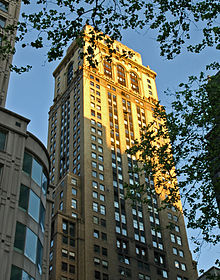Murray Hill (Manhattan)


Murray Hill is a neighborhood in Midtown in the New York borough of Manhattan .
To the south of Murray Hill, the blocks on Lexington Avenue in the 28th Street area are nicknamed "Curry Hill" because there are many Indian restaurants and specialty grocery stores here.
The Mercantile Building (10 East 40th Street ) is a particular example of Art Deco - Architecture .
location
The boundaries are East 34th Street in the south, East 42nd Street or East 40th Street in the north, Madison Avenue and Third Avenue in the west and the East River in the east. Administratively, Murray Hill is a member of Manhattan Community Board 6 .
Murray Hill is bordered by Rose Hill and Kips Bay to the south, Midtown East to the north, and Tenderloin and Koreatown to the west .
history
18th century
The name Murray Hill is derived from the name of the Murray family. They were Quakers and at that time traded mainly in goods from overseas as merchants. The head of the family Robert Murray (1721–1786) was born in Pennsylvania and moved to New York in 1753 after living briefly in North Carolina . He quickly gained a foothold as a businessman and made an impressive career.
Around 1762 Murray leased land from the city for a farm and large house, which he called Inclenberg (or Belmont), but which was commonly called Murray Hill. It stood on a hill that has since been removed. In its place is now Park Avenue and 36th Street . An avenue lined with various types of trees led to the large, square main building from Boston Post Road . It was surrounded on three sides by verandas, called "piazzas" in New York, with a view of the East River over Kips Bay .
The farmland covered an area of approximately 11.7 hectares . From today's perspective, the site began a few meters south of 33rd Street and extended north to the middle of the block between 38th Street and 39th Street . The lot was narrow at the south end, but at the north end it stretched roughly from Lexington Avenue to a point between Madison Avenue and Fifth Avenue .
Mary Lindley Murray successfully stopped William Howe and his army while George Washington withdrew from New York after the British landed at Kips Bay on September 15, 1776. Mrs. Murray asked the British officers to have tea on her property and was able to hold up British troops for a while - long enough for American troops to withdraw safely. According to the Rev. T. Dewitt Talmage , it preserved American independence by delaying Lord Howe long enough for Israel Putnam and his soldiers to join George Washington's units on Greenwich Road at the north end of the island before him Howe caught up. This delay likely saved 4,000 men from death or imprisonment.
19th century
During the 19th century, this neighborhood was an “uptown” neighborhood as this is where the city ended, where the New York Public Library and Bryant Park are now. To the north there was mostly farmland. During the winter of 1808, the port of New York was closed during Jefferson's trade embargo . The unemployed dockworkers were engaged in a job creation scheme: they removed between 6 and 12 meters of earth from Murray Hill to use for replenishment elsewhere.
From 1833 to 1837 a tram tunnel was built to run the New York and Harlem Railroad under Murray Hill. In the meantime the tunnel has been expanded and is now used for car traffic.
During the middle of the 19th century the upper class lived temporarily in Murray Hill - more permanently the upper middle class in the brownstone townhouses. So the Brick Presbyterian Church followed their congregation and sold their property at City Hall Park . It was rebuilt closer to its ward in 1857 - on Murray Hill (Fifth Avenue and 37th Street ).
However, when JP Morgan built his property on Madison Avenue / 37th Street in 1882 , which now houses part of the Morgan Library & Museum , this area was still considered elegant but a bit old-fashioned, as the wealthy are now up to the heights of Central Park's palaces on Fifth Avenue. Instead, fashion stores changed the neighborhood: for example, on Madison Square Park - which at the time was still part of Murray Hill - hip womenswear stores lined Fifth Avenue.
20th century
For most of the 20th century, this neighborhood was a quiet and rather stiff area with many affluent elderly residents. However, since the late 1990s, many professionals between the ages of 25 and 40 began moving here. On the weekends, this change is reflected in the noisy restaurant and bar scene along Third Avenue, which, strictly speaking, is a little east of Murray Hill.
Murray Hill is also the Graduate Center , the Stern College for Women of Yeshiva University , the Scandinavia House - The Nordic Center in America , the Mexican Cultural Institute of New York and the Union League Club of New York .
21st century
Although property and rental prices in this neighborhood are slightly cheaper than in nearby elegant parts of Manhattan, apartment prices here rose about 500 percent in a decade during the property boom of the late 1990s and early 2000s.
